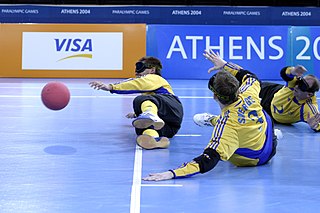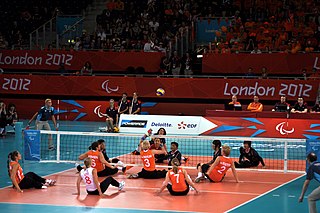 W
WThe Paralympic sports comprise all the sports contested in the Summer and Winter Paralympic Games. As of 2016, the Summer Paralympics included 22 sports and 526 medal events, and the Winter Paralympics include 5 sports and disciplines and about 72 events. The number and kinds of events may change from one Paralympic Games to another.
 W
WParalympic alpine skiing is an adaptation of alpine skiing for athletes with a disability. The sport evolved from the efforts of disabled veterans in Germany and Austria during and after the Second World War. The sport is governed by the International Paralympic Committee Sports Committee. The primary equipment used includes outrigger skis, sit-skis, and mono-skis. Para-alpine skiing disciplines include the Downhill, Super-G, Giant Slalom, Slalom, Super Combined and Snowboard.
 W
WPara-athletics is the sport of athletics practised by people with a disability as a parasport. The athletics events within the parasport are mostly the same as those available to able-bodied people, with two major exceptions in wheelchair racing and the club throw, which are specific to the division. The sport is known by various names, including disability athletics, disabled track and field and Paralympic athletics. Top-level competitors may be called elite athletes with disability.
 W
WParalympic cross-country skiing is an adaptation of cross-country skiing for athletes with disabilities. Paralympic cross-country skiing is one of two Nordic skiing disciplines in the Winter Paralympic Games; the other is biathlon. Competition is governed by the International Paralympic Committee (IPC).
 W
WWheelchair curling is an adaptation of curling for athletes with a disability affecting their lower limbs or gait. Wheelchair curling is governed by the World Curling Federation, and is one of the sports in the Winter Paralympic Games.
 W
WGoalball is a team sport designed specifically for athletes with a vision impairment. Participants compete in teams of three, and try to throw a ball that has bells embedded in it into the opponents' goal. The ball is thrown by hand and never kicked. Using ear-hand coordination, originating as a rehabilitation exercise, the sport has no able-bodied equivalent. Able-bodied athletes are also blindfolded when playing this sport.
 W
WPara Taekwondo is an adaptation of the sport of Taekwondo for athletes with an impairment. The World Taekwondo (WT) is the sport’s governing body for Para Taekwondo. In 2006, Para Taekwondo has begun developing the kyorugi (sparring) discipline. Since 2013, poomsae discipline is also being developed for Para athletes. On January 31, 2017 Para Taekwondo was confirmed as a sport for the 2020 Tokyo Paralympic Games program at the International Paralympic Committee (IPC) General Assembly the same year the WT became a full member of the IPC.
 W
WPara-badminton is a variant of badminton for athletes with a range of physical disabilities. Badminton World Federation (BWF) is the main governing body for para-badminton starting from June 2011. The sport was governed by Para Badminton World Federation (PBWF) until a unanimous decision to join BWF during a meeting in Dortmund in June 2011.
 W
WPara-cycling is the sport of cycling adapted for cyclists who have various disabilities. It is governed by the Union Cycliste Internationale (UCI). The sport consists of seven different events which include road and track races. The world's elite para-cyclists compete at Track and Road Worlds Championships, the Paralympic Games and the World Cup.
 W
WPararowing is a category of rowing race for those with physical, visual or intellectual disabilities.
 W
WParalympic shooting, also known as shooting Para sport, is an adaptation of shooting sports for competitors with disabilities. Shooting is a test of accuracy and control, in which competitors use pistols or rifles to fire a series of shots at a stationary target. Each shot is worth a maximum score of 10 or a decimal value of 10.9 points. Athletes use .22 caliber rifles, pistols and .177 caliber air guns. Paralympic shooting first appeared in the Summer Paralympics at the 1976 Toronto Games.
 W
WSledge hockey is an adaptation of ice hockey designed for players who have a physical disability. Invented in the early 1960s at a rehabilitation centre in Stockholm, Sweden, and played under similar rules to standard ice hockey, players are seated on sleds and use special hockey sticks with metal "teeth" on the tips of their handles to navigate the ice.
 W
WParalympic swimming is an adaptation of the sport of swimming for athletes with disabilities. Paralympic swimmers compete at the Summer Paralympic Games and at other sports competitions throughout the world. The sport is governed by the International Paralympic Committee. Both men and women compete in Paralympic swimming, racing against competitors of their own gender. Swimming has been a part of the Paralympic program since the 1960 Summer Olympics in Rome, Italy.
 W
WPara table tennis is a disabled sport which follows the rules set by the International Table Tennis Federation (ITTF). The usual table tennis rules are in effect with slight modifications for wheelchair athletes. Athletes from disability groups can take part. Athletes receive classifications between 1-11. Classes 1-5 are for those in wheelchairs and classes 6-10 for those who have disabilities that allow them to play standing. Within those groups, the higher classification means the more function the athlete has. Class 11 is defined for players with an intellectual disability.
 W
WSitting volleyball is a form of volleyball for athletes with a disability. As opposed to standing volleyball, sitting volleyball players must have at least one buttock in contact with the floor during the game.